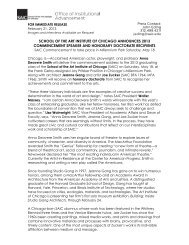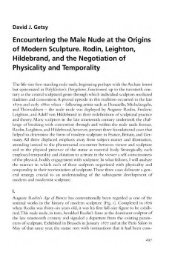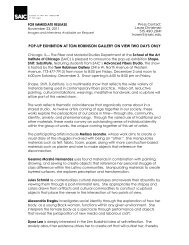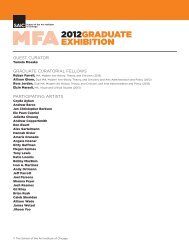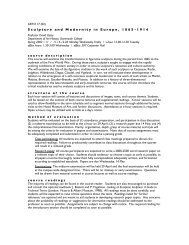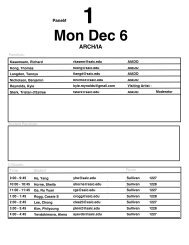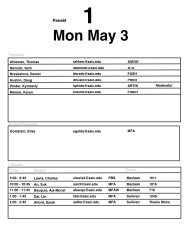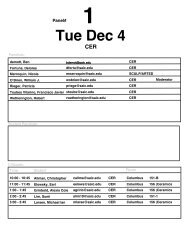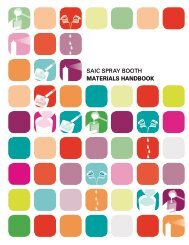i. institutional support and commitment to continuous improvement
i. institutional support and commitment to continuous improvement
i. institutional support and commitment to continuous improvement
You also want an ePaper? Increase the reach of your titles
YUMPU automatically turns print PDFs into web optimized ePapers that Google loves.
School of the Art Institute of Chicago<br />
Department of Architecture, Interior Architecture, <strong>and</strong> Designed Objects<br />
Master of Architecture<br />
Master of Architecture with emphasis in Interior Architecture<br />
- To allow the timely, less expensive printing of paper documents as needed<br />
- To create an archive of student work <strong>and</strong> curriculum initiatives as evidenced in student production.<br />
b) Technical Description Overview<br />
AIADO currently uses an internally developed system for archiving <strong>and</strong> reviewing student<br />
documents. This is built on a st<strong>and</strong>ard Linux / Apache / MySQL / PHP (LAMP) platform <strong>and</strong><br />
uses LDAP authentication <strong>and</strong> secure HTTP <strong>to</strong> limit access <strong>to</strong> its data <strong>and</strong> documents.<br />
c) Software<br />
This system contains two main components:<br />
o The “Drop Box”, an authenticated web system which allows faculty <strong>to</strong> upload <strong>and</strong><br />
assess documents from anywhere on the internet, rather than having <strong>to</strong> be on-campus<br />
or on the SAIC network. It cross-references SAIC data regarding faculty, AIADO courses,<br />
<strong>and</strong> rosters, with current NAAB assessment criteria, <strong>and</strong> allows faculty <strong>to</strong> easily review<br />
<strong>and</strong> assess only those documents relevant <strong>to</strong> their courses. Uploads <strong>to</strong> this system are<br />
au<strong>to</strong>matically packaged, indexed <strong>and</strong> transferred <strong>to</strong> the Archive described below.<br />
o The Archive, which exists on a separate, limited-access server, provides long-term<br />
s<strong>to</strong>rage of the uploaded documents. Access <strong>to</strong> this system is restricted <strong>to</strong> selected<br />
groups via LDAP, <strong>and</strong> is only available <strong>to</strong> teams working on accreditation or similar proj-<br />
ects, as-needed. This system also provides a complex searching <strong>and</strong> reporting interface,<br />
including searches of text within each document, in order <strong>to</strong> identify <strong>and</strong> view docu-<br />
ments pertaining <strong>to</strong> specific semesters, courses <strong>and</strong>/or accordance with specific NAAB<br />
criteria.<br />
d) Hardware<br />
Two separate servers exist for this system, <strong>and</strong> both reside in restricted segments of the Art<br />
Institute’s data center. Each system is backed up <strong>and</strong> maintained by a team of system admin-<br />
istra<strong>to</strong>rs, according <strong>to</strong> enterprise maintenance st<strong>and</strong>ards.<br />
e) Data input procedure overview<br />
o Students receive precise instructions on documenting their work in course syllabi.<br />
Work that addresses appropriate <strong>and</strong> agreed upon NAAB Student Performance Criteria,<br />
<strong>and</strong> schematic work leading up <strong>to</strong> finished work, should be part of the final compilation<br />
each student prepares <strong>and</strong> turns in at the end of each semester.<br />
o Students produce work using InDesign in PDF format, normally 24” x 36” for consis-<br />
tency, with a specific file-naming pro<strong>to</strong>col, <strong>and</strong> submits disc <strong>to</strong> faculty.<br />
o Faculty examine the PDF work from each student, s<strong>to</strong>ring it on their faculty com-<br />
puter hard drives, <strong>and</strong> correcting the naming pro<strong>to</strong>col as necessary.<br />
o Faculty access the data entry interface of the system (each new course must get its<br />
course data through software hooks from the registrar’s PeopleSoft system).<br />
o Faculty select student names, performance criteria, <strong>and</strong> assessment terms from pull<br />
down lists with minimal keypunched data entry. This becomes the meta-data file.<br />
o At the end of data entry Faculty upload PDFs of each individual student in<strong>to</strong> the<br />
archive system.<br />
o Faculty review digital course documents, then print <strong>to</strong> paper <strong>and</strong> save <strong>to</strong> DVD the<br />
NAAB course book, including syllabus, assignments, h<strong>and</strong>-outs, <strong>and</strong> readings.<br />
o For newer versions of previously uploaded projects, as happens with incompletes,<br />
these are marked as subsequent <strong>to</strong> old versions. Old versions do not get upgraded or<br />
Architecture Program Report | 142



